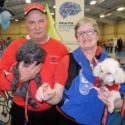All Judy Gilbert-Lindsay had to do was put on the red shirt and her dogs would wag their tails with excitement. Unfortunately for both her and her dogs, though, Gilbert-Lindsay had to retire the red shirt to the back of her closet.
Since May 2018, Gilbert-Lindsay has decided to step down from her position as division co-ordinator of Brant-Haldimand-Norfolk County for the St. John’s Ambulance therapy dog program.
The program is dedicated to relieving stress and anxiety in people, from elderly folk living with Alzheimer’s to students gearing up for exams to young children learning how to read.
“There wasn’t a year where we didn’t do over 100 hours of volunteering; the dogs had 60 to 70 visits apiece,” said Gilbert-Lindsay.
Gilbert-Lindsay had been volunteering with the St. John’ Ambulance therapy dog program for the past 10 years, five of which were as a volunteer handler before stepping into the leadership role of co-ordinator.
There was a host of reasons why Gilbert-Lindsay felt that she had to take a step back from co-ordinator position, but ultimately it was because her dogs Tigger and Mandy are aging. Since May 2018, St. John’s Ambulance has not yet found a person to fill the position in this division — despite interviewing various applicants.
Until they can find a volunteer to step into the co-ordinator position, the therapy dog program at Brant-Haldimand-Norfolk County has been suspended until further notice.
Christina Klassen, branch manager at St. John’s Ambulance, is upset that the division is being suspended, but she is hopeful that they will eventually fill the position.
“It is difficult to fill the leadership position because it is a volunteer position. It does take quite a bit of time,” Klassen said. “We’ll continue to look for someone to fill it and there will be someone who will fill it.”
When speaking about their experiences with the therapy dog program both Klassen and Gilbert-Lindsay struggled not to get emotional. Both have had experience as volunteers for the organization before working their way up to leadership positions.
Gilbert-Lindsay said that there is always something good that comes out of every visit, from every nursing home to every school.
“The activity co-ordinators in the places know the day their coming and they say: ‘this person is in the room not able to come out, we’d like you to call on them and it’s an amazing experience for both you and the dog’,” Gilbert-Lindsay said.
Klassen shared the sentiment that there are amazing stories that come out of the therapy dog program every day.
“We have dogs that go to school … and they sit with kids that have some difficulty reading and the kids get to read to the dogs one-on-one in a quiet area of the school and it helps these kids to learn and feel more confident reading out loud,” said Klassen.
Klassen has said that the program tries to foster an environment that is both encouraging and non-judgemental for the kids.
“It’s amazing, it truly is. It’s sad that we have to do this but you know, it’s part of volunteering,” Klassen said about the division program being suspended.
Situations like these are a harsh reality for organizations that depend on the commitment of volunteers to do the work that is so greatly needed.
“Especially with changes in government and with the decrease in financial resources in not-for-profits, they’re relying more and more on volunteers to keep the program and services going,” said Kerri Emberlin, team leader of volunteer engagement at Alzheimer Society for Brant-Haldimand-Norfolk-Hamilton.
These divisions at the Alzheimer Society and at the St. John’s Ambulance therapy dog program have regularly collaborated on the Alzheimer’s walk together and both have experienced a dip in volunteer turnout and initiative at their own respective organizations.
Emberlin, Klassen and Gilbert-Lindsay all agree that there is a lot that goes into volunteering these days.
“It’s a balance between having the appropriate staffing resources as well as engaging the right volunteers with the right skill sets and experiences to keep those programs up and running,” said Emberlin.
Emberlin described the wide variety of programs and services that the Alzheimer’s Society provides and the unique journey it takes to find the right person with the right skill set for the job.
“We run an exercise program and we need volunteers with some rec experience,” said Emberlin. “We need office volunteers but office volunteers now versus office volunteers 20 years ago would typically have paper files that would be kept up, but now we need people with computer skills because we operate off of databases and computer programs now.”
Klassen compares what it first took for her to get a volunteer position at St. John’s back when she was first applying and what it takes now.
“I was a volunteer here many many years ago and I just walked in and said: ‘hi, i’d like to volunteer here’ and they were like ‘great, we’d love to have you’ and that’s it and it’s definitely not like that anymore,” Klassen said.
The significance of the volunteer has shifted from what it was in previous decades. Whereas volunteers in the past could just walk in and get a job with an organization, there are many criteria that individuals now have to meet. Volunteers go through thorough background checks and fulfill organizations’ specific criteria.
Each of Gilbert-Lindsay’s dogs had to go through two evaluations to meet St. John’s criteria for the therapy dog program before they got accepted into the program.
Despite having to step down from the co-ordinator position, Gilbert-Lindsay has said that she has had a great time volunteering for the past 10 years. “They were awesome volunteers, they enjoyed the work they were doing and they had excellent dogs.”




